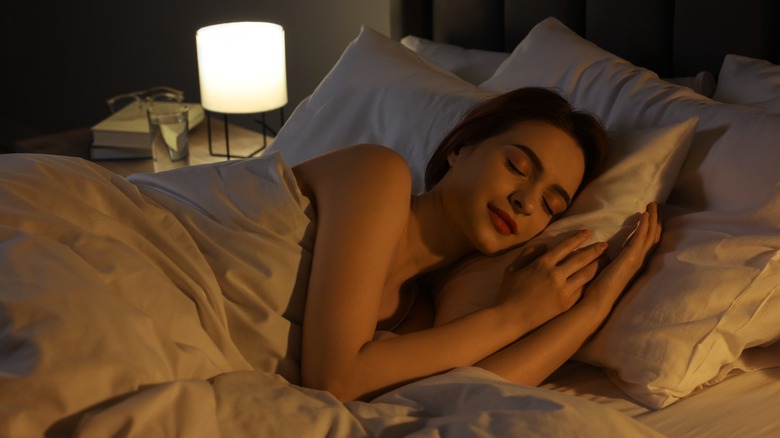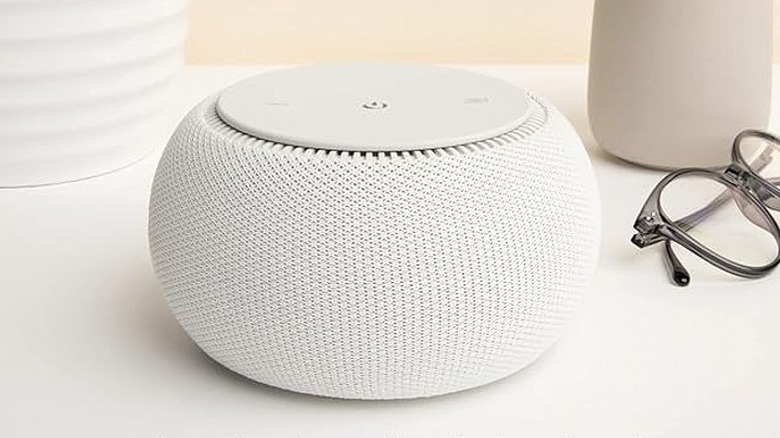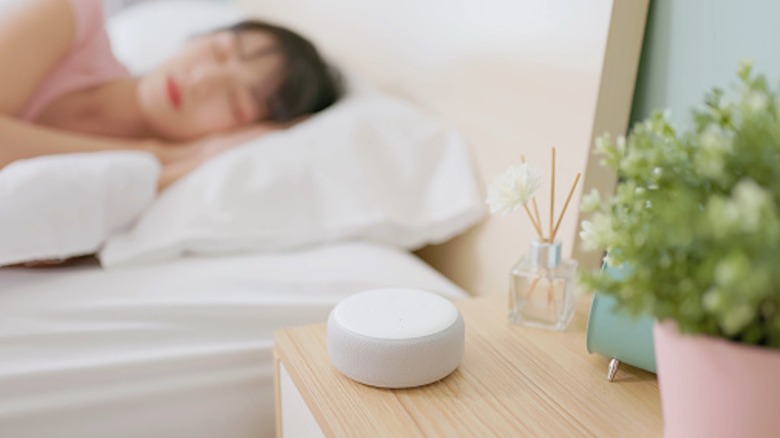This Bedroom Essential Holds The Key To A Good Night's Sleep
We may receive a commission on purchases made from links.
Over 35% of American adults subsist through their day on under seven hours of sleep (via America's Health Rankings), and that's alarming. Poor sleep raises diminishes quality of life and increases susceptibility to numerous diseases, including diabetes, heart issues, dementia, and cancer. Although becoming conscious of these downsides has spurred many to adopt measures like wearing eye masks, choosing the best mattress, and going dark on social media before hitting the pillows, the deluge of a good night's sleep persists. Not anymore! It's time to turn things around by investing in a trendy bedroom essential: a white noise machine.
People often level the blame at the cacophony of traffic, yapping street dogs, raucous neighbors, or a snoring partner for their shallow repose. But, let's admit it, even if there was needle-drop silence, our tossing and turning, primal heartbeats, or sheer breathing could turn bothersome — amplified manifolds in those going through menopause. By playing a steady rhythm, white noise machines or sound conditioners fight din (or stillness) with their idea of noise, ultimately lulling our brains into a deep sleep. While they may not be as helpful to those suffering from insomnia, a lot of people swear that white noise machines help them catch more z's.
How do white noise machines improve sleep?
Despite being coined "white noise machines," these sleep assistants aren't limited to emitting white noise. They include a whole spectrum of colors, including pink, brown, and green noises. To clarify, white noise consists of sound frequencies ringing with the same intensity — think back to when the TV ran a grating static when programs went off-air (and the accompanying disappointment). On the other hand, pink noise softens this jarring sound by playing lower frequencies with higher intensity. This lends it a deeper tone reminiscent of beach waves, rustling leaves, or composed rainfall.
Brown noise is pink noise with a greater passion. So, the emanating sound is grainier, like that of a cascading waterfall or the inside of an airplane, which some research has found is ideal for those with tinnitus. As for green noise, it's reminiscent of nature. Chirping crickets often make the repertoire, although gardeners might not catch a wink of sleep. Essentially, when you hear the constant lull of the white noise machine, your brain is conditioned to treat it as a cue to turn out the noise in your brain. Simultaneously, the white noise drowns out all distractions — conversation, loud shoes, fidgety cats, or road traffic are non-issues — ensuring you don't wake up until your alarm blares.
Don't keep the white noise machine running all night
While there's plenty of anecdotal evidence backing the marketing claims (and logic) of using white noise machines to optimize your bedroom for the best night's sleep, the science remains unclear. A 2021 study published in Sleep Medicine Reviews surmised most positive research wasn't carried out at scale to yield meaningful results. Moreover, results often oscillated between extremities, with white noise either being helpful or downright disruptive. Another 2021 study, published in the International Journal of Pediatric Otorhinolaryngology, found that some white noise machines geared towards babies could do more harm than good if played at their maximum volume or placed too close to their cribs. There's also some fear that constant exposure to white noise can eventually trigger hearing loss in its users because their auditory system never gets a break, although these claims are unproven so far.
That being the case, it's best to be cautious. Instead of running the white noise devices all night, stick to playing them at their lowest volume and set their timers to go off after 30 minutes, or the time it typically takes for sleep to take over. In case you're using the devices around your little ones, arrange your furniture a certain way to help you sleep better. This means, ensuring the white noise machine is over 7 feet away and plays at under 50 decibels. A sound decibel app, like Sound Meter, can help if the machine doesn't state the necessary information.


